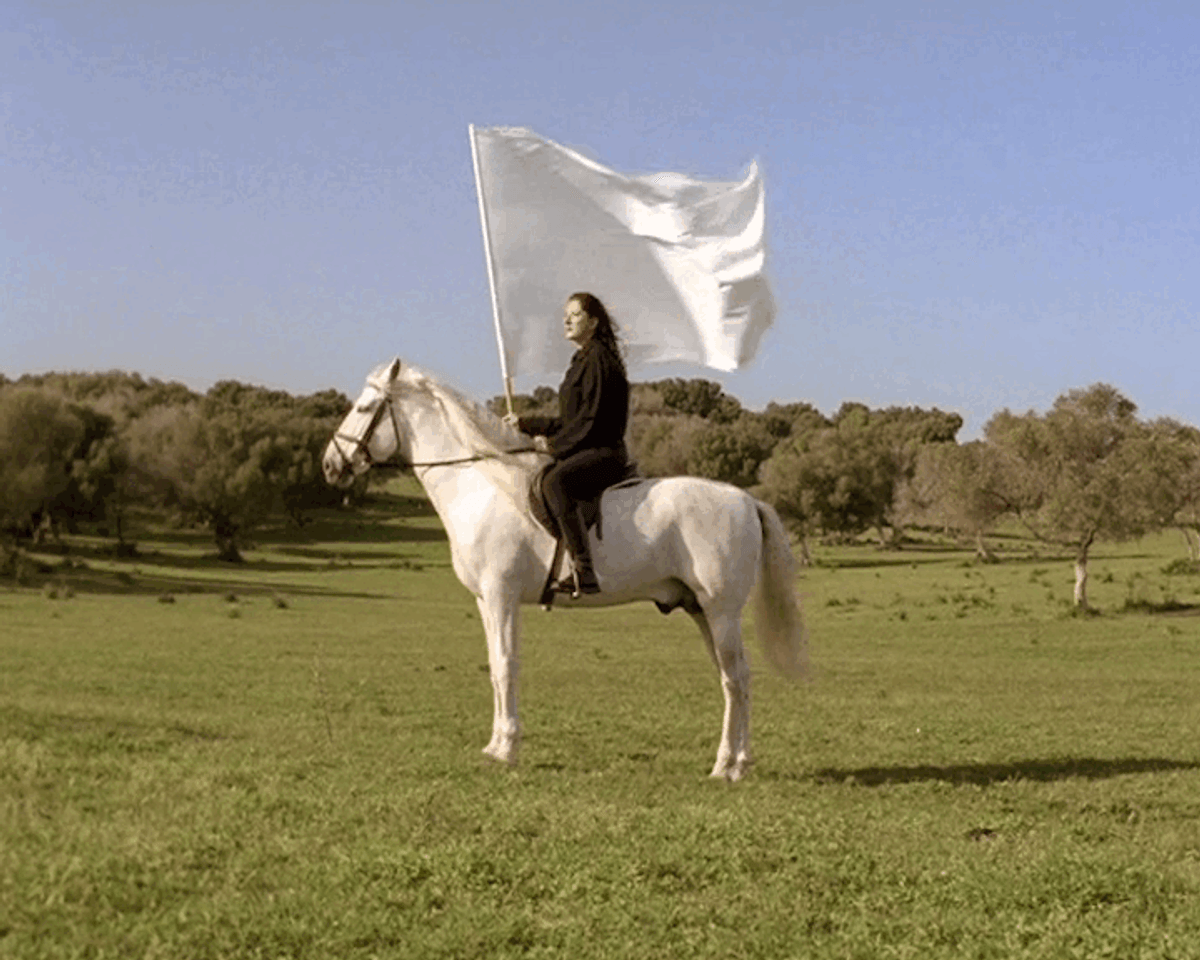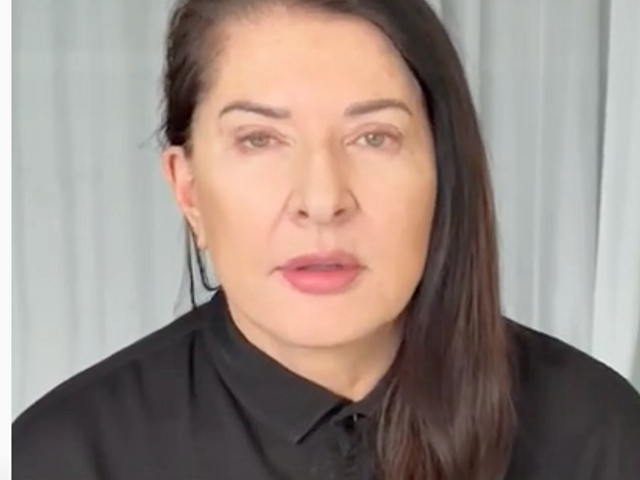When I filmed The Hero in 2001, I was grieving the loss of my father. Vojo was a national hero, a soldier who fought the Nazis with the Yugoslav partisans, communists led by Tito. He was a very handsome man, with a strong, stern face and a thick, powerful-looking head of hair. In pictures of him from the war he is almost always riding a white horse. He fought with a group of guerrillas who made lightning raids on the Germans. It took impossible courage. Many of his friends were killed alongside him.
In The Hero, I am sitting on a white horse, just as my father so often did, and holding a large white flag that flutters in the wind. Why a white flag? My father never surrendered to anything. But he was capable of surprising me. I remember, in 1968, as students in Yugoslavia protested against the government to demand freedom and rights, he did something heroic that impressed me not just with its bravery but with its solidarity and its compassion. Handsome in his raincoat and necktie, his hair piled up majestically, he stood in the middle of Marx and Engels Square and gave a passionate speech renouncing his membership with the Communist Party and denouncing Yugoslavia’s "Red Bourgeoisie", who controlled the government. At the climax of his oration he threw his party membership card into the crowd—an amazing gesture. Everyone applauded wildly. I was so proud of him.
In 2001, Vojo died, and white is also the colour of death. In the end, we must all surrender to change.
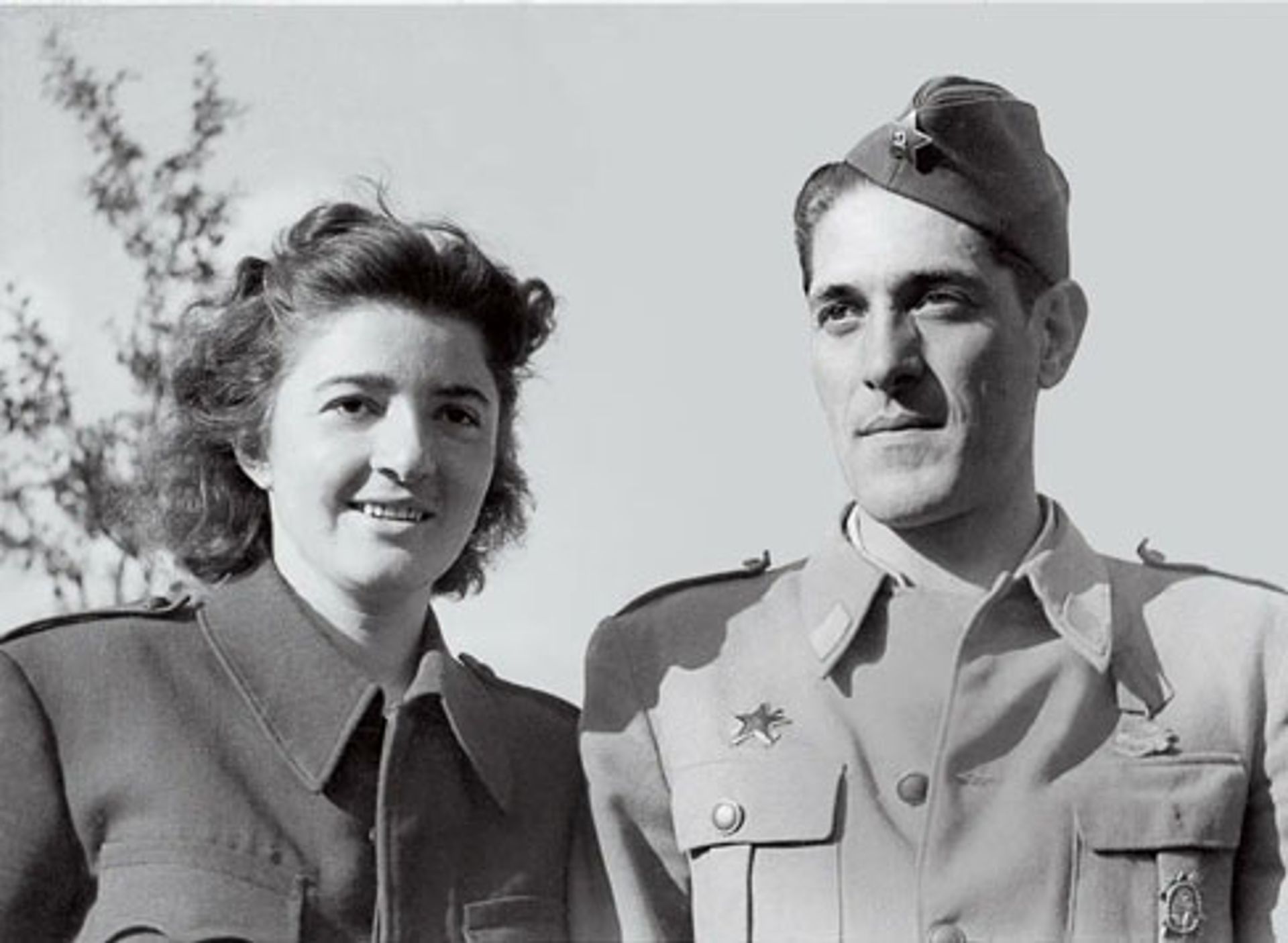
Marina Abramović's parents, Danica and Vojo Abramović in 1945 Courtesy of the Marina Abramović Archives
Today, the work I made as an homage to my father has a brand new life. A work I originally recorded in 2001 is now being presented every evening for three months on London’s Piccadilly Lights and other important screens in Seoul, Milan, Berlin, Dublin, Tokyo and New York, as part of my Circa 2022 commission. It appears with a new narration I have written to echo the Artist's Life Manifesto I completed in 2011, called The Heroes’ Manifesto.
This change—from writing a manifesto for artists to one for heroes—has happened now, because courage and heroism are the qualities that the time we live in demands. Right now, we are at such a strange moment: we are destroying our planet and seeing wars going on all over the world. What can an artist do? Art is not going to save us. Today, I am telling people that we have to be adaptable. Right now, we need heroes; less artists but more heroes.
Our planet needs uncorrupted heroes with morality, who embody courage and bring real change. Every day is a shaky, uncertain, constantly changing landscape. On the Circa network of screens, we have this white horse. This white flag. This beautiful land. We need heroes that can bring new light to illuminate us. Heroes that can inspire us to be better, and to work together, not against each other. Heroes who care.
Today, a hero could be Txai Surui, a young climate activist who was the only Indigenous woman to speak at the Cop26 climate conference, who challenged world leaders to take strong action and reminded us that “it is always necessary to believe the dream is possible.” It could be Nadya Tolokonnikova of Pussy Riot who raised $6.7m in the first days after the Russian invasion to support Ukraine. Or it could be President Volodymyr Zelensky, who stands alone as a leader with courage, at a time when the morality of our politicians is at such a low. In 2022, the white flag I held all those years ago stands for peace.
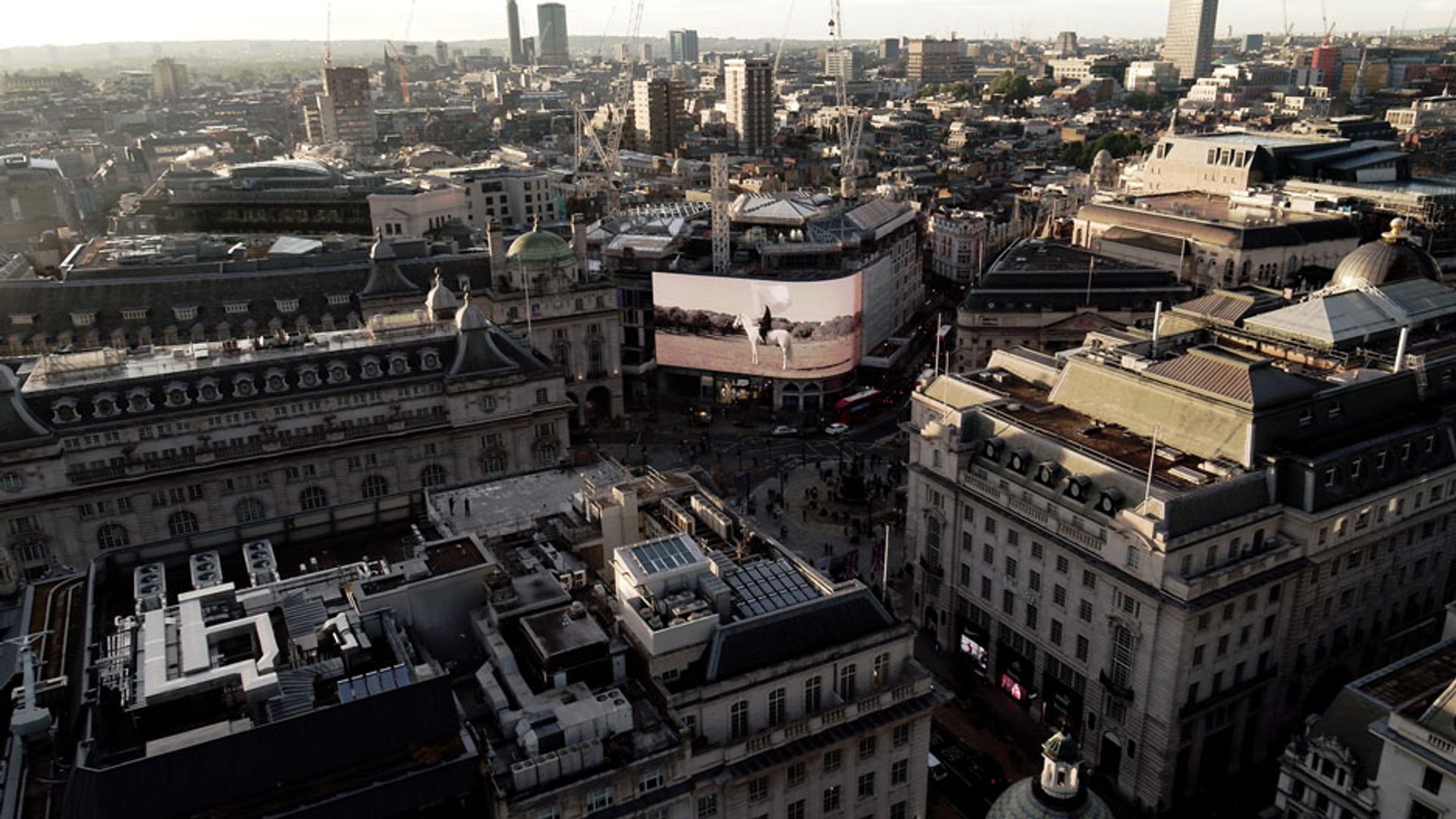
The Hero by Marina Abramović at Piccadilly Lights © Circa
This work is now a global call for new heroes. Today, heroes can come bearing white flags. They can come in many forms: pacifist, feminine, self-sacrificial, collective. The first thing you see on the screen is a woman on the horse. His Holiness the Dalai Lama said that, next time, he is not going to reincarnate as a man but as a woman. Finally. Women have a different type of energy. But there is more than this. It has always been very important to create strong images. I can't predict what each person looking at The Hero will take away. As Marcel Duchamp said, the public has to complete the work. Why this heroic posture, with the horse that dominates the landscape? Why is this landscape there? All of this is unanswered, I want the public to complete the work with their own interpretation, to see in it their own ideas of heroism.
My first NFT
My favourite philosopher Noam Chomsky once said: "We shouldn’t be looking for heroes, we should be looking for good ideas." Right now, I think we need both. First, we must ask who can bring the solutions we need. The heroes—the ones who sacrifice everything—can bring new light to illuminate this world. These new heroes are the ones I have set out to support, starting today. It's really about finding solutions to these catastrophes. These solutions are why I am creating my first NFT collection, The Hero 25FPS. I never set out to create an NFT—it came as a surprise. Like all of my previous performances, there is always an element of risk involved. I didn’t do an NFT for a while, because I needed to find the right idea that really worked. This is such a new medium for me that I was immediately thinking of how to connect with some kind of history or performance art.
The first thing that came to my mind was 1959, when Yves Klein, on a bridge over the Seine, sold to his collectors Zone de Sensibilité Picturale Immatérielle to achieve perfect immaterialisation. This simple work involved the sale of empty space, in exchange for gold. If the buyer wished, the piece could then be completed in an elaborate ritual in which the buyer would burn the receipt, and Klein would throw half of the gold into the river. All that was left was just ashes in the river. If you think about performance art, too, it’s always about immateriality. You can’t frame and hang a performance on the wall. In my opinion, this ritualistic moment ignited conceptualism and influenced me very early on in my development as a performance artist.
I am selling each individual frame of The Hero (2001) as part of The Hero 25FPS, which stands for frames per second. As with all my work, the audience completes the work. My first performance on the blockchain will invite people to purchase either a single frame (.jpg) or a sequence of frames (.gif) to acquire time. Following this, a percentage will fund new heroism. How? I am inviting people working within Web3 to submit ideas on the nft.circa.art website. Ideas that make the world a better, more beautiful place. People who demonstrate heroic vision will then receive a grant in the coming months. I want to see what other ideas people have in this Web3 space to help save our planet. The grants we shall award from The Hero 25FPS is my small way of contributing to this future.
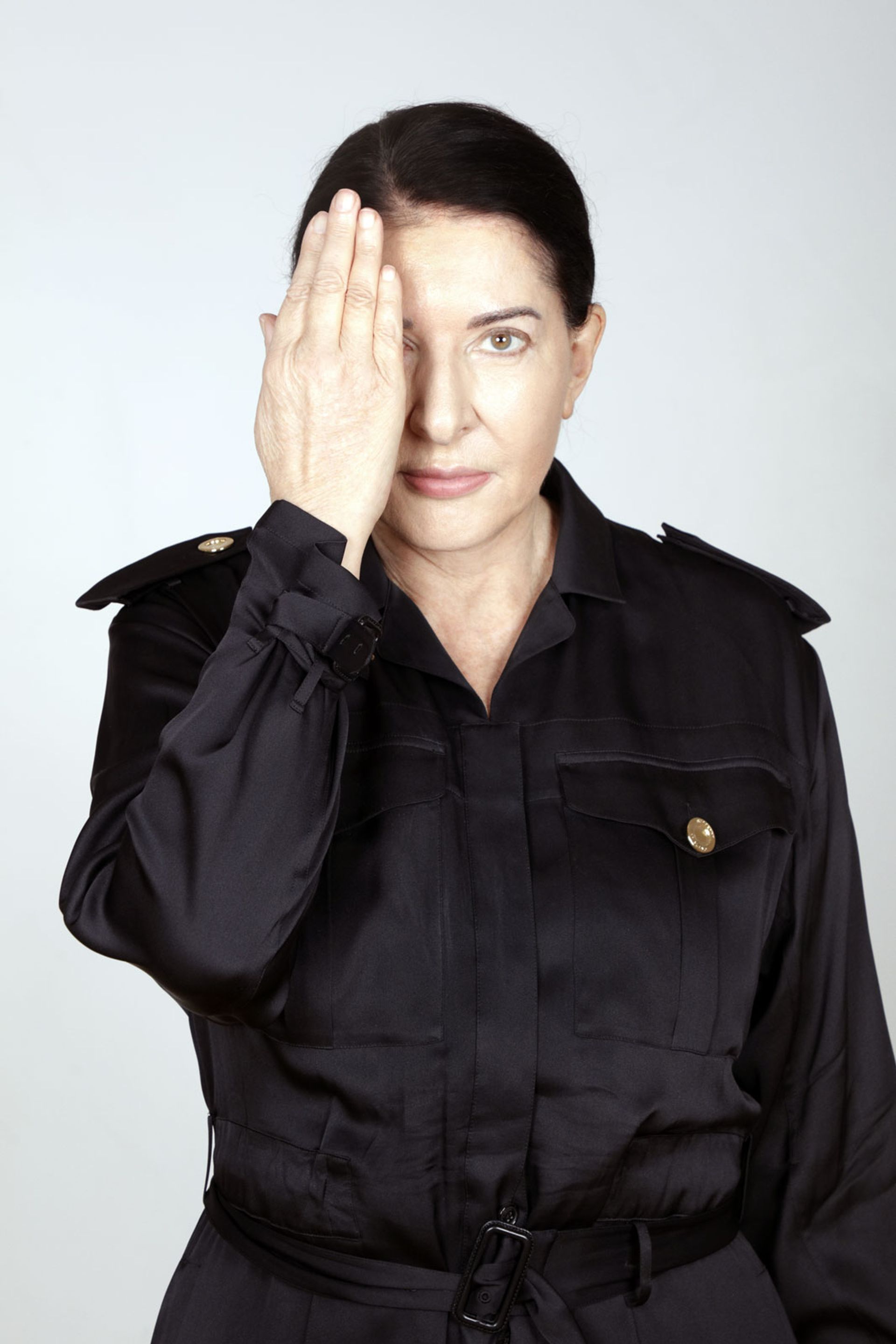
Marina Abramović Photo: Marco Anelli © 2022
I do not know how the hero grant winners will look. I am throwing the net out wide. Gavin Wood, who coined the term Web3 in 2014, said decentralised technologies are the only hope to save liberal democracy. We’re beginning to see how they can make a difference in the world. Bail Bloc Project, an app developed by culture magazine The New Inquiry, allows anyone to volunteer computing power to mine cryptocurrency that is used to pay for Americans without bail funds to get out of jail. I’ve been interested to learn about DAOs, “decentralized autonomous organisations” that are owned by members and operate transparently on the internet. One of these organisations, Cowgirl DAO is raising funds for abortion rights through the sale of cowgirl art NFTs. Beginning in May in Dallas, with the work of the photographer and artist Molly Dickson, it aims to challenge the terrible news of the Supreme Court overturning Roe v. Wade, and continue to provide access for all to abortion rights.
If Web3 projects can give aid to victims of war, reunite families divided by jail, and restore access to reproductive health, I want to find out what other heroic impacts they can have in the real world. I'd say to the young kids of Web3, just don't give up. Because you're the future. You have the vision but it takes time for this to become a vision of greatness. It doesn't happen overnight and can take lots of work.
To me, the entire world has always been divided between two categories: the originals and the ones who follow. The originals are not just made up of artists, but scientists, doctors, fashion designers, film-makers, and writers, too. When I founded the Marina Abramović Institute it was dedicated to incubating a dialogue between science, art, technology and even spirituality, all of it immaterial. Many originals produce tangible things but other practices—music, theatre, and the study of the natural world—are essentially immaterial. Today, we need people with this vision to create new ways of learning and forms of art that haven’t even been invented yet. We need people who can bring new light.
I said before that art is not going to save us. But ideas will save us. And art can contribute to fomenting these ideas. Strong images can help. And a hardcore message. The rest I will leave open. I will never turn away from art but I am excited by the possibilities that lie alongside it—and beyond it. Art is always going to exist. Since humanity exists, art exists. Today, we need heroes.


